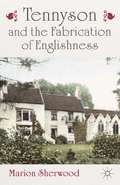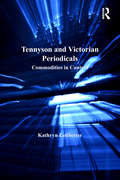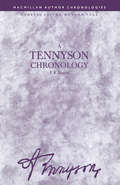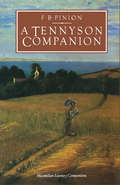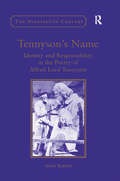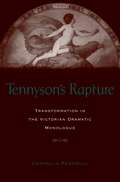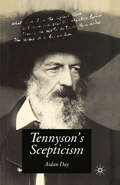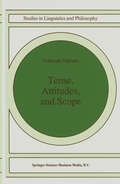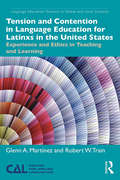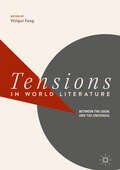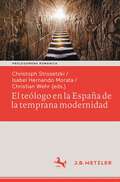- Table View
- List View
Tennyson and the Fabrication of Englishness
by M. SherwoodThrough an examination of Tennyson's 'domestic poetry' - his portrayals of England and the English - in their changing nineteenth-century context, this book demonstrates that many of his representations were 'fabrications', more idealized than real, which played a vital part in the country's developing identity and sense of its place in the world.
Tennyson and Victorian Periodicals: Commodities in Context (The Nineteenth Century Series)
by Kathryn LedbetterThis is the first book-length study of Tennyson's record of publication in Victorian periodicals. Despite Tennyson's supposed hostility to periodicals, Ledbetter shows that he made a career-long habit of contributing to them and in the process revealed not only his willingness to promote his career but also his status as a highly valued commodity. Tennyson published more than sixty poems in serial publications, from his debut as a Cambridge prize-winning poet with "Timbuctoo" in the Cambridge Chronicle and Journal to his last public composition as Poet Laureate with "The Death of the Duke of Clarence and Avondale" in The Nineteenth Century. In addition, poems such as "The Charge of the Light Brigade" were shaped by his reading of newspapers. Ledbetter explores the ironies and tensions created by Tennyson's attitudes toward publishing in Victorian periodicals and the undeniable benefits to his career. She situates the poet in an interdependent commodity relationship with periodicals, viewing his individual poems as textual modules embedded in a page of meaning inscribed by the periodical's history, the poet's relationship with the periodical's readers, an image sharing the page whether or not related to the poem, and cultural contexts that create new meanings for Tennyson's work. Her book enriches not only our understanding of Tennyson's relationship to periodical culture but the textual implications of a poem's relationship with other texts on a periodical page and the meanings available to specific groups of readers targeted by individual periodicals.
Tennyson and Victorian Periodicals: Commodities in Context (The Nineteenth Century Series)
by Kathryn LedbetterThis is the first book-length study of Tennyson's record of publication in Victorian periodicals. Despite Tennyson's supposed hostility to periodicals, Ledbetter shows that he made a career-long habit of contributing to them and in the process revealed not only his willingness to promote his career but also his status as a highly valued commodity. Tennyson published more than sixty poems in serial publications, from his debut as a Cambridge prize-winning poet with "Timbuctoo" in the Cambridge Chronicle and Journal to his last public composition as Poet Laureate with "The Death of the Duke of Clarence and Avondale" in The Nineteenth Century. In addition, poems such as "The Charge of the Light Brigade" were shaped by his reading of newspapers. Ledbetter explores the ironies and tensions created by Tennyson's attitudes toward publishing in Victorian periodicals and the undeniable benefits to his career. She situates the poet in an interdependent commodity relationship with periodicals, viewing his individual poems as textual modules embedded in a page of meaning inscribed by the periodical's history, the poet's relationship with the periodical's readers, an image sharing the page whether or not related to the poem, and cultural contexts that create new meanings for Tennyson's work. Her book enriches not only our understanding of Tennyson's relationship to periodical culture but the textual implications of a poem's relationship with other texts on a periodical page and the meanings available to specific groups of readers targeted by individual periodicals.
A Tennyson Chronology (Author Chronologies Series)
by F B PinionThe presentation of Tennyson's personal and poetic development is supplemented by an introduction, brief biographical sketches of more than 30 of his friends, and maps of relevant areas in Lincolnshire and the Isle of Wight.
A Tennyson Companion: Life and Works (Literary Companions)
by F. PinionThough it gives separate treatment to genres such as idylls, epistolary poems, and popular dramatic monologues, this major assessment of Tennyson's work is broadly chronological. His variety of interest and the excellence of his later poetry are emphasized (most of the significant contributions to Idylls of the King belong to the final period of its development). Observing due proportion as far as possible, this perceptive and unusually comprehensive survey assesses the literary merits of Tennyson and the modern significance of his ideas. Its value is enhanced by a detailed biographical introduction and a generous selection of illustrations.
Tennyson's Name: Identity and Responsibility in the Poetry of Alfred Lord Tennyson (The Nineteenth Century Series)
by Anna BartonSeeking to understand Tennyson's poetry as the work of a man concerned with making and then living up to one of the most famous names in Victorian literature, Anna Barton offers close readings of Tennyson's major works. From his obscure beginning as 'A.T.', one of two anonymous brothers, to the height of his success, when he held the impressive title 'Alfred Lord Tennyson, DCL, Poet Laureate', the development of Tennyson's career took place in a period increasingly aware that a name could command considerable cultural capital. In the marketplace goods were sold on the strength of their brand name; in the press the battle for signed articles was fought and won; and in Victorian drawing rooms young ladies collected the autographs of family and friends and pasted them into scrap books. From his early lyrics to his Arthurian Idylls, Barton argues, the laureate's keen sense of professional identity forced him to grapple with modern concerns about the ethics of print in order to establish his own responsible poetic.
Tennyson's Name: Identity and Responsibility in the Poetry of Alfred Lord Tennyson (The Nineteenth Century Series)
by Anna BartonSeeking to understand Tennyson's poetry as the work of a man concerned with making and then living up to one of the most famous names in Victorian literature, Anna Barton offers close readings of Tennyson's major works. From his obscure beginning as 'A.T.', one of two anonymous brothers, to the height of his success, when he held the impressive title 'Alfred Lord Tennyson, DCL, Poet Laureate', the development of Tennyson's career took place in a period increasingly aware that a name could command considerable cultural capital. In the marketplace goods were sold on the strength of their brand name; in the press the battle for signed articles was fought and won; and in Victorian drawing rooms young ladies collected the autographs of family and friends and pasted them into scrap books. From his early lyrics to his Arthurian Idylls, Barton argues, the laureate's keen sense of professional identity forced him to grapple with modern concerns about the ethics of print in order to establish his own responsible poetic.
Tennyson’s Poems: New Textual Parallels
by R. H. WinnickIn Tennyson’s Poems: New Textual Parallels, R. H. Winnick identifies more than a thousand previously unknown instances in which Tennyson phrases of two or three to as many as several words are similar or identical to those occurring in prior works by other hands—discoveries aided by the proliferation of digitized texts and the related development of powerful search tools over the three decades since the most recent major edition of Tennyson’s poems was published. Each of these instances may be deemed an allusion (meant to be recognized as such and pointing, for definable purposes, to a particular antecedent text), an echo (conscious or not, deliberate or not, meant to be noticed or not, meaningful or not), or merely accidental. Unless accidental, Winnick writes, these new textual parallels significantly expand our knowledge both of Tennyson’s reading and of his thematic intentions and artistic technique. Coupled with the thousand-plus textual parallels previously reported by Christopher Ricks and other scholars, he says, they suggest that a fundamental and lifelong aspect of Tennyson’s art was his habit of echoing any work, ancient or modern, which had the potential to enhance the resonance or deepen the meaning of his poems. The new textual parallels Winnick has identified point most often to the King James Bible and to such canonical authors as Shakespeare, Milton, Dryden, Pope, Thomson, Cowper, Shelley, Byron, and Wordsworth. But they also point to many authors rarely if ever previously cited in Tennyson editions and studies, including Michael Drayton, Richard Blackmore, Isaac Watts, Erasmus Darwin, John Ogilvie, Anna Lætitia Barbauld, Letitia Elizabeth Landon, John Wilson, and—with surprising frequency—Felicia Hemans. Tennyson’s Poems: New Textual Parallels is thus a major new resource for Tennyson scholars and students, an indispensable adjunct to the 1987 edition of Tennyson’s complete poems edited by Christopher Ricks.
Tennyson's Rapture: Transformation in the Victorian Dramatic Monologue
by Cornelia D. PearsallIn the wake of the death of his friend Arthur Henry Hallam, the subject of In Memoriam, Alfred Tennyson wrote a range of intricately connected poems, many of which feature pivotal scenes of rapture, or being carried away. This book explores Tennyson's representation of rapture as a radical mechanism of transformation-theological, social, political, or personal-and as a figure for critical processes in his own poetics. The poet's fascination with transformation is figured formally in the genre he is credited with inventing, the dramatic monologue. Tennyson's Rapture investigates the poet's previously unrecognized intimacy with the theological movements in early Victorian Britain that are the acknowledged roots of contemporary Pentacostalism, with its belief in the oncoming Rapture, and its formative relation to his poetic innovation. Tennyson's work recurs persistently as well to classical instances of rapture, of mortals being borne away by immortals. Pearsall develops original readings of Tennyson's major classical poems through concentrated attention to his profound intellectual investments in advances in philological scholarship and archeological exploration, including pressing Victorian debates over whether Homer's raptured Troy was a verifiable site, or the province of the poet's imagination. Tennyson's attraction to processes of personal and social change is bound to his significant but generally overlooked Whig ideological commitments, which are illuminated by Hallam's political and philosophical writings, and a half-century of interaction with William Gladstone. Pearsall shows the comprehensive engagement of seemingly apolitical monologues with the rise of democracy over the course of Tennyson's long career. Offering a new approach to reading all Victorian dramatic monologues, this book argues against a critical tradition that sees speakers as unintentionally self-revealing and ignorant of the implications of their speech. Tennyson's Rapture probes the complex aims of these discursive performances, and shows how the ambitions of speakers for vital transformations in themselves and their circumstances are not only articulated in, but attained through, the medium of their monologues.
Tennyson's Rapture: Transformation in the Victorian Dramatic Monologue
by Cornelia D. PearsallIn the wake of the death of his friend Arthur Henry Hallam, the subject of In Memoriam, Alfred Tennyson wrote a range of intricately connected poems, many of which feature pivotal scenes of rapture, or being carried away. This book explores Tennyson's representation of rapture as a radical mechanism of transformation-theological, social, political, or personal-and as a figure for critical processes in his own poetics. The poet's fascination with transformation is figured formally in the genre he is credited with inventing, the dramatic monologue. Tennyson's Rapture investigates the poet's previously unrecognized intimacy with the theological movements in early Victorian Britain that are the acknowledged roots of contemporary Pentacostalism, with its belief in the oncoming Rapture, and its formative relation to his poetic innovation. Tennyson's work recurs persistently as well to classical instances of rapture, of mortals being borne away by immortals. Pearsall develops original readings of Tennyson's major classical poems through concentrated attention to his profound intellectual investments in advances in philological scholarship and archeological exploration, including pressing Victorian debates over whether Homer's raptured Troy was a verifiable site, or the province of the poet's imagination. Tennyson's attraction to processes of personal and social change is bound to his significant but generally overlooked Whig ideological commitments, which are illuminated by Hallam's political and philosophical writings, and a half-century of interaction with William Gladstone. Pearsall shows the comprehensive engagement of seemingly apolitical monologues with the rise of democracy over the course of Tennyson's long career. Offering a new approach to reading all Victorian dramatic monologues, this book argues against a critical tradition that sees speakers as unintentionally self-revealing and ignorant of the implications of their speech. Tennyson's Rapture probes the complex aims of these discursive performances, and shows how the ambitions of speakers for vital transformations in themselves and their circumstances are not only articulated in, but attained through, the medium of their monologues.
Tennyson's Scepticism
by Aidan DayTennyson is not known for his scepticism. This book argues that he should be. It proposes a revaluation of the way in which his work is read. Tennyson has always been understood as a poet who is committed primarily to endorsing spiritual values. But this study argues that much of his poetry is driven by a metaphysical scepticism that is associated, in part, with rational perspectives deriving from Enlightenment thought. The scepticism in Tennyson's poetry partakes in the complex generation of the modern that was taking place in his era. One of the purposes of the study is to demonstrate that a cultural studies approach to Tennyson trivialises his intellectual subtlety and complexity. Making extensive critical use of Tennyson's manuscript drafts, this study provides close readings of Tennyson's earlier, shorter poems, together with the principal works of his maturity including In Memoriam , Maud and The Lover's Tale , and will be a valuable resource for Tennyson students and scholars worldwide.
Tense and Aspect: From Semantics to Morphosyntax (Oxford Studies in Comparative Syntax)
by Alessandra Giorgi Fabio PianesiThe authors bridge the gap between the semantic and syntactic properties of verb tense and aspect, and suggest a unified account of tense and aspect using Chomsky's Principles and Parameters Framework. They compare tense and aspect systems in Romance languages with Germanic ones.
Tense, Attitudes, and Scope (Studies in Linguistics and Philosophy #58)
by T. OgiharaTense, Attitudes, and Scope is a model-theoretic inquiry into the semantics of tense in natural language. The book presents the view that the semantic contribution of tense is made in relation to structurally higher expressions (the `relative tense theory') and argues against the view that tenses are all indexicals. This idea is formally encoded as a de se analysis of attitudes, originally proposed by Lewis, coupled with a sequence-of-tense rule posited for English. An auxiliary proposal is made to account for some exceptional cases (e.g. so-called double-access sentences), which invokes de re attitudes about temporal entities (states or intervals). Since the proposed account assumes that the interpretation of tense is structure-dependent, it also correctly predicts scope interactions between tenses and NPs. Tense, Attitudes, and Scope is intended for scholars and graduate students in formal semantics, syntax-semantics interface, philosophy of language and Japanese linguistics.
Tense Future: Modernism, Total War, Encyclopedic Form
by Paul K. Saint-AmourWe know that trauma can leave syndromes in its wake. But can the anticipation of violence be a form of violence as well? Tense Future argues that it can-that twentieth-century war technologies and practices, particularly the aerial bombing of population centers, introduced non-combatants to a coercive and traumatizing expectation. During wartime, civilians braced for the next raid; during peacetime they braced for the next war. The pre-traumatic stress they experienced permeates the century's public debates and cultural works. In a series of groundbreaking readings, Saint-Amour illustrates how air war prophets theorized the wounding power of anticipation, how archive theory changed course in war's shadow, and how speculative fiction conjured visions of a civilizational collapse that would end literacy itself. And in this book's central chapters, he shows us how Ford Madox Ford, Robert Musil, James Joyce, Virginia Woolf, and other interwar modernist writers faced the memory of one war and the prospect of another, some by pitting their fictions' encyclopedic scale and formal turbulence against total war, others by conceding war's inevitability while refusing to long for a politically regressive peace. Total war: a conflict that exempts no one, disregarding any difference between soldier and civilian. Tense Future forever alters our understanding of the concept of total war by tracing its emergence during the First World War, its incubation in air power theory between the wars, and above all its profound partiality. For total war, during most of the twentieth century, meant conflict between imperial nation states; it did not include the violence those states routinely visited on colonial subjects during peacetime. Tacking back and forth between metropole and colony, between world war and police action, Saint-Amour describes the interwar refashioning of a world system of violence-production, one that remains largely intact in our own moment of perpetual interwar.
TENSE FUTURE C: Modernism, Total War, Encyclopedic Form
by Paul K. Saint-AmourWe know that trauma can leave syndromes in its wake. But can the anticipation of violence be a form of violence as well? Tense Future argues that it can-that twentieth-century war technologies and practices, particularly the aerial bombing of population centers, introduced non-combatants to a coercive and traumatizing expectation. During wartime, civilians braced for the next raid; during peacetime they braced for the next war. The pre-traumatic stress they experienced permeates the century's public debates and cultural works. In a series of groundbreaking readings, Saint-Amour illustrates how air war prophets theorized the wounding power of anticipation, how archive theory changed course in war's shadow, and how speculative fiction conjured visions of a civilizational collapse that would end literacy itself. And in this book's central chapters, he shows us how Ford Madox Ford, Robert Musil, James Joyce, Virginia Woolf, and other interwar modernist writers faced the memory of one war and the prospect of another, some by pitting their fictions' encyclopedic scale and formal turbulence against total war, others by conceding war's inevitability while refusing to long for a politically regressive peace. Total war: a conflict that exempts no one, disregarding any difference between soldier and civilian. Tense Future forever alters our understanding of the concept of total war by tracing its emergence during the First World War, its incubation in air power theory between the wars, and above all its profound partiality. For total war, during most of the twentieth century, meant conflict between imperial nation states; it did not include the violence those states routinely visited on colonial subjects during peacetime. Tacking back and forth between metropole and colony, between world war and police action, Saint-Amour describes the interwar refashioning of a world system of violence-production, one that remains largely intact in our own moment of perpetual interwar.
Tense in English: Its Structure and Use in Discourse (Routledge Library Editions: The English Language)
by Renaat DeclerckFirst published in 1991, this book looks at tense in English, one of the most controversial areas of grammar. Prior to the book’s original publication, the problems and interest in the subject had led to an impressive number of books and articles. Yet, despite the amount of work produced, nothing approaching a consensus had emerged, merely a series of conflicting theories and analyses. Here, Renaat Declerck provides a framework for a theoretical instrument which will enable the linguist to interpret the data correctly. The book is primarily theoretical in nature, but offers descriptive theory and a discussion of the various tenses which will make it a valuable tool for those teaching English. Theoretical and applied linguists will find this an important contribution to the debate on tense and a worthy starting point for future research. The book is not written from the viewpoint of any particular linguistic theory and does not presuppose any knowledge of tense theory, it is a readable and reliable guide to the area.
Tense in English: Its Structure and Use in Discourse (Routledge Library Editions: The English Language)
by Renaat DeclerckFirst published in 1991, this book looks at tense in English, one of the most controversial areas of grammar. Prior to the book’s original publication, the problems and interest in the subject had led to an impressive number of books and articles. Yet, despite the amount of work produced, nothing approaching a consensus had emerged, merely a series of conflicting theories and analyses. Here, Renaat Declerck provides a framework for a theoretical instrument which will enable the linguist to interpret the data correctly. The book is primarily theoretical in nature, but offers descriptive theory and a discussion of the various tenses which will make it a valuable tool for those teaching English. Theoretical and applied linguists will find this an important contribution to the debate on tense and a worthy starting point for future research. The book is not written from the viewpoint of any particular linguistic theory and does not presuppose any knowledge of tense theory, it is a readable and reliable guide to the area.
Tension and Contention in Language Education for Latinxs in the United States: Experience and Ethics in Teaching and Learning (Language Education Tensions in Global and Local Contexts)
by Glenn A. Martínez Robert W. TrainApplying a critical lens to language education, this book explores the tensions that Latinx students face in relation to their identities, social and institutional settings, and other external factors. Across diverse contexts, these students confront complex debates and contestable affirmations that intersect with their lived experiences and social histories. Martinez and Train highlight the pedagogic and ethical urgency of teacher responsibility, learner agency and social justice in critically addressing the consequences, constraints, and affordances of the language education that Latinx students experience in historically-situated and institutionally defined spaces of practice, ideology and policy. Reframing language studies to take into account the roles of power, inequality, and social settings, this book provokes dialogue between areas of language education that rarely interface. Through privileging the learner experience, the book provides a window to the contested spaces across language education and generates new opportunities for engagement and action. Offering nuanced and insightful analyses, this book is ideal for scholars, language researchers, language teacher educators and graduate students in all areas of language education.
Tension and Contention in Language Education for Latinxs in the United States: Experience and Ethics in Teaching and Learning (Language Education Tensions in Global and Local Contexts)
by Glenn A. Martínez Robert W. TrainApplying a critical lens to language education, this book explores the tensions that Latinx students face in relation to their identities, social and institutional settings, and other external factors. Across diverse contexts, these students confront complex debates and contestable affirmations that intersect with their lived experiences and social histories. Martinez and Train highlight the pedagogic and ethical urgency of teacher responsibility, learner agency and social justice in critically addressing the consequences, constraints, and affordances of the language education that Latinx students experience in historically-situated and institutionally defined spaces of practice, ideology and policy. Reframing language studies to take into account the roles of power, inequality, and social settings, this book provokes dialogue between areas of language education that rarely interface. Through privileging the learner experience, the book provides a window to the contested spaces across language education and generates new opportunities for engagement and action. Offering nuanced and insightful analyses, this book is ideal for scholars, language researchers, language teacher educators and graduate students in all areas of language education.
Tensions in World Literature: Between the Local and the Universal
by Weigui FangThis collection gives a diversified account of world literature, examining not only the rise of the concept, but also problems such as the relation between the local and the universal, and the tensions between national culture and global ethics. In this context, it focuses on the complex relationship between Chinese literature and world literature, not only in the sense of providing an exemplary case study, but also as an introspection and re-location of Chinese literature itself. The book activates the concept of world literature at a time when it is facing the rising modern day challenges of race, class and culture.
Tensions of Social History: Sources, Data, Actors and Models in Global Perspective
by Alessandro StanzianiThis book seeks to overcome the tension between 'western' and 'non-western' categories and tools in the study of global history, showing how most western approaches to the social sciences and history have developed through transnational and colonial interactions. Offering a transnational and global history of the main tools we have to understand the word and its transformations over the last three centuries, Tensions of Social History explores the construction of archives and historical memory, the making of statistics and their use in politics, the identification of social actors, and the emergence of key social theories. Providing key insights into how to write history and develop social sciences in the global era while avoiding eurocentrism and cultural exceptionalism, this ambitious book shows how global history is made of encounters rather than confrontations between civilizations.
Tensions of Social History: Sources, Data, Actors and Models in Global Perspective
by Alessandro StanzianiThis book seeks to overcome the tension between 'western' and 'non-western' categories and tools in the study of global history, showing how most western approaches to the social sciences and history have developed through transnational and colonial interactions. Offering a transnational and global history of the main tools we have to understand the word and its transformations over the last three centuries, Tensions of Social History explores the construction of archives and historical memory, the making of statistics and their use in politics, the identification of social actors, and the emergence of key social theories. Providing key insights into how to write history and develop social sciences in the global era while avoiding eurocentrism and cultural exceptionalism, this ambitious book shows how global history is made of encounters rather than confrontations between civilizations.
The Tenth Muse: Essays in Criticism (Routledge Revivals: Herbert Read and Selected Works)
by Herbert ReadThis book, first published in 1957, is a collection of Herbert Read’s essays on various topics. The essays explore many different subjects and themes, including art, literature, religion and philosophy. This title will be of interest to a variety of readers.
The Tenth Muse: Essays in Criticism (Routledge Revivals: Herbert Read and Selected Works)
by Herbert ReadThis book, first published in 1957, is a collection of Herbert Read’s essays on various topics. The essays explore many different subjects and themes, including art, literature, religion and philosophy. This title will be of interest to a variety of readers.
El teólogo en la España de la temprana modernidad: Formas de vida seculares y espirituales. Impacto político, social y estético (Prolegomena Romanica. Beiträge zu den romanischen Kulturen und Literaturen)
by Christoph Strosetzki Isabel Hernando Morata Christian WehrEste volumen analiza el lugar y el perfil del teólogo en el Siglo de Oro español. Los capítulos que lo integran se centran no solo en los miembros del clero católico, sino también en los seguidores de corrientes religiosas como el recogimiento, el dejamiento, el alumbradismo y la devotio moderna. La figura del teólogo se aborda desde las perspectivas de los estudios literarios y culturales, la teología y la filosofía. Son objeto de atención la concepción que el teólogo tenía de sí mismo, su actitud, conocimiento, formación, influencias y actividades, que atestiguan los tratados, los textos ficcionales y la literatura religiosa del Siglo de Oro. Se plantean cuestiones como las consecuencias de la Reforma y la Contrarreforma en la imagen de los teólogos, sus relaciones familiares y económicas con otros miembros de la sociedad, y el importante papel que alcanzaron en este período como autores literarios.Dieser Sammelband analysiert den gesellschaftlichen Ort und das Profil des Theologen im Siglo de Oro, wobei auch Vertreter religiöser Lehren, die nicht dem katholischen Klerus angehörten, also Repräsentanten der Strömungen des recogimiento, dejamiento, alumbradismo oder der devotio moderna Berücksichtigung finden. Es kommen die Perspektiven vor allem von Literatur- und Kulturwissenschaft, Theologie und Philosophie zu Wort. Analysiert werden Selbstverständnis, Haltung, Wissen und Ausbildung, Einflussbereich und Tätigkeitsfeld der Theologen, wie sie in Traktaten, fiktionalen Texten und religiöser Literatur bezeugt werden. Dabei werden Fragenkomplexe diskutiert wie z.B. die nach den Folgen von Reformation und Gegenreformation für das Selbstverständnis des Theologen, nach den familiären und wirtschaftlichen Bindungen der Theologen oder nach der bedeutenden Rolle von Theologen als Autoren in der Literatur der Zeit.
